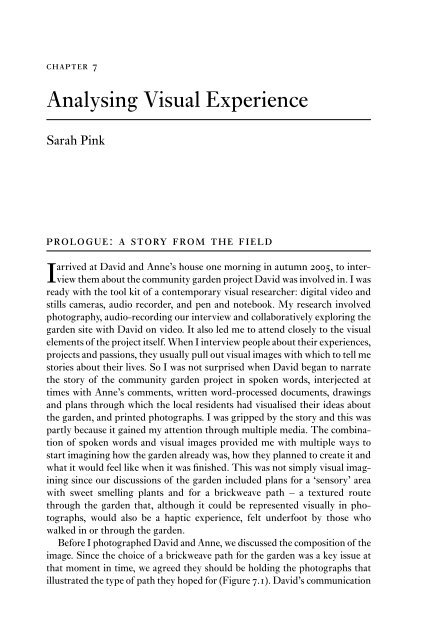Research Methods for Cultural Studies
Research Methods for Cultural Studies
Research Methods for Cultural Studies
Create successful ePaper yourself
Turn your PDF publications into a flip-book with our unique Google optimized e-Paper software.
chapter 7<br />
Analysing Visual Experience<br />
Sarah Pink<br />
prologue: a story from the field<br />
I arrived at David and Anne’s house one morning in autumn 2005, to interview<br />
them about the community garden project David was involved in. I was<br />
ready with the tool kit of a contemporary visual researcher: digital video and<br />
stills cameras, audio recorder, and pen and notebook. My research involved<br />
photography, audio-recording our interview and collaboratively exploring the<br />
garden site with David on video. It also led me to attend closely to the visual<br />
elements of the project itself. When I interview people about their experiences,<br />
projects and passions, they usually pull out visual images with which to tell me<br />
stories about their lives. So I was not surprised when David began to narrate<br />
the story of the community garden project in spoken words, interjected at<br />
times with Anne’s comments, written word-processed documents, drawings<br />
and plans through which the local residents had visualised their ideas about<br />
the garden, and printed photographs. I was gripped by the story and this was<br />
partly because it gained my attention through multiple media. The combination<br />
of spoken words and visual images provided me with multiple ways to<br />
start imagining how the garden already was, how they planned to create it and<br />
what it would feel like when it was finished. This was not simply visual imagining<br />
since our discussions of the garden included plans <strong>for</strong> a ‘sensory’ area<br />
with sweet smelling plants and <strong>for</strong> a brickweave path – a textured route<br />
through the garden that, although it could be represented visually in photographs,<br />
would also be a haptic experience, felt underfoot by those who<br />
walked in or through the garden.<br />
Be<strong>for</strong>e I photographed David and Anne, we discussed the composition of the<br />
image. Since the choice of a brickweave path <strong>for</strong> the garden was a key issue at<br />
that moment in time, we agreed they should be holding the photographs that<br />
illustrated the type of path they hoped <strong>for</strong> (Figure 7.1). David’s communication


